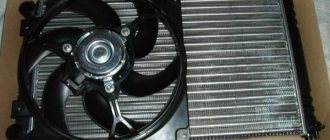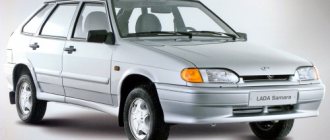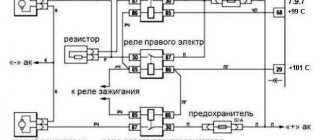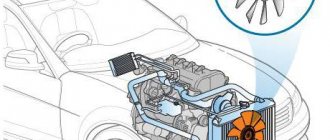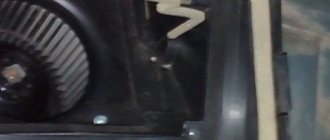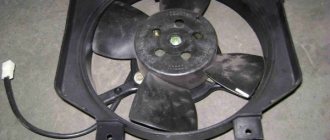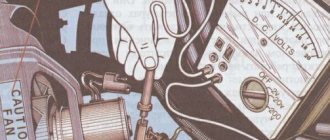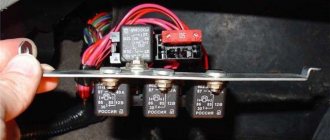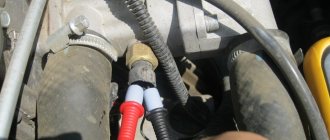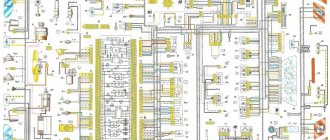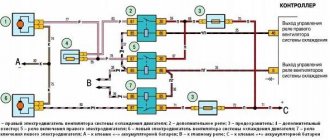Cooling system fans do not work on Chevrolet Niva
The causes of the malfunction may be different:
- Burnt fuse;
- Fan wedge;
- There is no voltage supply to the fans due to acidified connections;
- Relay malfunction;
- Malfunction of the coolant temperature sensor (temperature sensor);
In order to check the presence of voltage on the fans and ensure the integrity of the fuses and relays, you need to remove the clip from the coolant temperature sensor (thermal sensor) and start the car engine.
coolant temperature sensor
After you start the engine, the fans should turn on in emergency mode.
If this happens, it means the coolant temperature sensor (temperature sensor) is faulty and needs to be replaced. temperature sensor
If emergency activation does not occur, it is necessary to check the fans for external damage and jamming, the wires supplying voltage to them, fuses and relays.
If the relay is faulty, the fans may constantly work and not turn off. This occurs due to wear of the relay; the contacts in it burn out and do not open. The electric fan relays are located behind the glove compartment, on the passenger side. In diagram 1, marked with numbers 5 and 6. Fuses (50A), marked with numbers 2 and 9.
Fuses (50A)
2 - Fuse (50A) of the right electric fan;
9 - Fuse (50A) of the left electric fan;
Diagram 1. Relay and fuse box (located behind the glove compartment)
Popular materials
Not available, for the year of manufacture either. The fans will turn on only based on the sensor signal. Tip: The crankshaft position sensor makes it difficult to remove the fans. Starter
From the chip connected to one of the fans, we remove the negative wire; it is usually black. But in this case, in order to turn on the fans at high speeds, you will need to redo everything back. The most popular are electric-driven fans, which consist of an electric motor, an electronic control unit, a temperature sensor and a fan switch relay. Crankshaft position sensor. Except for the tee. Let's look at the diagram Connecting Niva fans in a serial connection. Injection system fuse box. We drag the harness over the steering column and move a piece of hose along it so that its middle is above the steering shaft. Distributor NIVA. Control of transfer case levers in all modes. Practice. Differentials NIVA 1h
Types of radiator cooling fan drive
The radiator cooling fan can have two types of drive - mechanical and electrical. Mechanical is often used on diesel engines of trucks and tractors. Their engine has a longitudinal arrangement, so the water pump is located in front and is driven by a belt from the crankshaft. An impeller is attached to the pump itself, which provides air flow to the radiator. Since the rotation of the pump must be constant, the fan supplies air all the time.
Some cars use a mechanical fan drive, but additionally there is a clutch that allows you to turn off the fan itself, while the water pump continues to operate normally.
On passenger cars, an electrically driven cooling fan is more often used. To put it simply, such a device is simply a 12-volt electric motor with an impeller attached to its rotor.
Installing additional radiator fans on a Gazelle
Something else useful for you:
This fan does not work all the time; it only turns on when a certain temperature level is exceeded. The liquid temperature is determined by a sensor, which controls the operation of the fan.
When the temperature is exceeded, the sensor turns on the fan and it provides additional air flow to cool the liquid. As soon as the temperature drops, the sensor turns off the device.
So the cooling system fan has only one function, but it is very important - to reduce the temperature of the fluid so that the engine does not overheat.
When the car is moving, the fan rarely turns on, since the air flow is quite sufficient. But when parked with the engine running, for example, in a traffic jam, there is no air flow, the temperature rises quickly and you can’t do without a fan.
Operating principle
The cooling system of VAZ Niva models does not come into contact with the atmosphere in operating condition, and therefore requires pressure. The coolant is antifreeze with a freezing point of 40 degrees Celsius. The composition of the solution is water and ethylene glycol. The total volume of the cooling circuit is 10.7 liters. Antifreeze can boil after a temperature of +110 degrees Celsius.
The main functional unit in the system is the thermostatic valve, which distributes the coolant flow depending on the engine temperature. The thermostat, controlled by a temperature-sensitive sensor, regulates the direction of movement of antifreeze. A simplified work flow looks like this:
- Before the internal combustion engine warms up to operating temperature (+90 degrees Celsius), the cooler moves along a small circuit (interior heating radiator, thermostat, power plant) using a pump.
- The damper opens towards the large circuit where the radiator is located, at a temperature of + 80 degrees Celsius. Afterwards, virtually the entire cooler moves along a large circuit, mainly cooling through the radiator.
- The small ring is not blocked, but a minimum of antifreeze enters it due to pipes of a smaller diameter.
- In model 2121, the fan is mounted on the axis of the water pump and constantly directs the air flow to the (BC). Cooling fans in Niva 21214 and 2131 are paired with electric drive. They are activated alternately or together using a temperature sensor (switching temperature is about 100 degrees Celsius).
- When heated, excess antifreeze is sent to the expansion tank, increasing the pressure in the system, which reduces the boiling threshold of the coolant.
In summer and during transition periods in models with an injector, the movement of the cooler is limited by a special tap. The Niva Chevrolet model does not have such a blocker, so the heating is turned off by directing the air flow past the heat exchanger.
What's the result?
As you can see, the internal combustion engine itself and its systems require regular maintenance. As for the cooling system, it is also no exception and requires special attention.
If the driver notices that the cooling fan has started to work at maximum speed all the time or has stopped turning off in a timely manner, then the first thing you should do is check the antifreeze level, the functionality of the pump and thermostat.
It is also necessary to take into account that the reason for such fan operation may be a clogged cooling radiator or too high outside air temperature, shorted contacts, etc. We should not forget that the fan can constantly spin on a cold engine when the air conditioner is running.
Common engine cooling system failures: water pump, thermostat, radiator, cooling fan and others. How to determine the reasons yourself.
Design and principle of operation of a radiator cooling fan. Common faults, troubleshooting and repairs. Tips for use.
Why does the engine overheat? What should the driver expect and what damage may occur if the engine overheats. What to do if the internal combustion engine overheats.
Pump device. The operating principle of a centrifugal pump, an engine cooling system with two pumps and a switchable pump. Pump malfunctions and repairs.
Basic malfunctions of a car radiator of the engine cooling system. Soldering a brass radiator, do-it-yourself repair of an aluminum radiator.
Radiator in the cooling system, design and principle of operation, thermoregulation of the coolant. Troubleshooting and self-repair
Thermostat malfunction
A thermostat failure on a Niva can be accompanied by two malfunctions:
- long engine warm-up;
- fast warm-up with overheating;
In the first case, the thermostat is constantly open and liquid circulates through the radiator all the time. Because of this, in winter the Niva engine does not warm up or warms up for too long. In rare cases, the temperature on the track may drop.
In the second case, the thermostat valve is closed all the time. Fluid does not pass through the radiator. Because of this, she is unable to lower her temperature. Therefore, the engine overheats constantly. To get rid of the problem, the thermostat needs to be replaced.
The fan on the Chevrolet Niva does not work, or it constantly works & | Auto-assistance
If there is no control signal, we can talk about a failed relay.
Niva Chevrolet fan operation from sensors and buttons
If the cooling fan does not turn on on a Chevrolet Niva, the first thing you need to do is check the condition of the fuses responsible for the operation of the unit.
Why doesn't the cooling fan work? If this resistor burns out or the relay fails, the fan...
It happens that fans do not turn on due to deformation of the plastic casings of the parts.
In the photo below you can see the appearance of the Chevrolet Niva product.
The right fan relay is activated after the control signal is received from terminal number six to terminal number. This allows you to switch to a high fan speed. If there is no control signal, we can talk about a failed relay.
At the same time, the cooling fan on the right side of the Chevrolet Niva does not turn on. It is important to remember that the same control signal is responsible for turning on the left fan. In this case, a jumper process occurs between terminals 85 and 86.
However, the fan motor on the left is powered via a separate fuse. The cooling fans on the Chevrolet Niva do not turn on even if the sensor that detects the coolant temperature breaks down.
How Fans Work on a Chevrolet Niva
How fans work on the Chevrolet field
Tips for motorists
The favorable thermal conditions of the Chevrolet Niva SUV engine are supported by a cooling system in which two corresponding fans play an important role, providing the necessary air flow through the radiator core. If the fan fails, the cooling system cannot cope with removing excess heat from the engine, and it begins to overheat. Since the number of fans on the Chevrolet Niva has doubled, the electrical circuitry of the fans has become more complex than on conventional cars.
If the temperature gauge needle is near the red part of the scale and the system fans do not turn on, you will have to stop and start troubleshooting. To do this, remove the cover of the additional mounting block located under the front panel (under the glove compartment) in the area of the front passenger's feet. Two fuses protect the fan motor circuits. If the fuse protecting the right circuit of the engine is blown, both fans will not turn on, and if the second one works, only the left one will not turn on. fan .
In one block there are three relays that are responsible for turning on the right fan at low and high speeds and turning on the left fan at high rotation speeds . The auxiliary relay should operate when a control signal is applied to its terminal No. 86 from terminal No. 46 (ECM). In this case, the voltage at the fan motor terminals will be supplied through a resistor. When the resistor burns or the relay fails, the fan speed is low. operation .
Forced cooling fans on Chevrolet Niva
If you watched this video, then don't try to write your stupid comments, I didn't upload it for that.
Chevrolet Niva fans
Hi all! Like it, subscribe to the channel and tell your friends. There are many other interesting things.
The right fan relay is energized when the control module (ECM) terminal No. 86 is applied to terminal No. 86. The fan should then operate at high speed . If there is no control signal or this relay is not working, the correct fan will not turn on. The same control signal also contains the left fan, since there is a jumper between terminals No. 86 and No. 85 of the right and left relays to turn on the fans. But the power from the left fan motor goes through its fuse.
Also, both fans will not turn on if the coolant temperature (DOT) sensor is faulty. Because it is its data on the antifreeze temperature that determines the controller’s decision on whether to turn on the fans or not.
Due to the high temperature inside the engine compartment, cases of deformation of the plastic fan housings occur, and when they are turned on, the rotating fan blades touch the housing. As a result, the tips of the blades are heated to the melting point. When the fans are turned off, the blades are welded to the housing and will not work when turned on again.
see also
Comments 21
On a 2005 shnivy, the temperature for turning on the fans was set in the on-board computer (bk staff)
As an option, but first I want to restore work with factory settings.
Before this is a firmware glitch. Replace the firmware with a newer one.
Good afternoon This is a firmware glitch. I also have a 2006 Chevy, firmware 122_01 - it’s buggy, it worked almost the same as yours. Just not 15 seconds, but 5 seconds. I upgraded it to the next serial number (b122hr91) and it started working fine.
How is it? Where can I read it and what do I need for this?
Yes, it’s not difficult, here on the drive there was an article on bosch firmware 7.9.7+. I bought a diagnostic cable for 300 rubles a long time ago, VAG KKL 409, and so you can sew with it without any problems. There’s no way I’ll add an article to the BZ. If necessary, I can email you the information.
Call an electrician and have him change the algorithm for turning on the fans. I immediately turned on 2 fans to maximum. And the temperature is immediately reduced, and they do not work for long. About 30 seconds in hot weather. Disconnect the battery terminal for 7-10 minutes, it may help clear the errors.
We still need to find such an electrician
